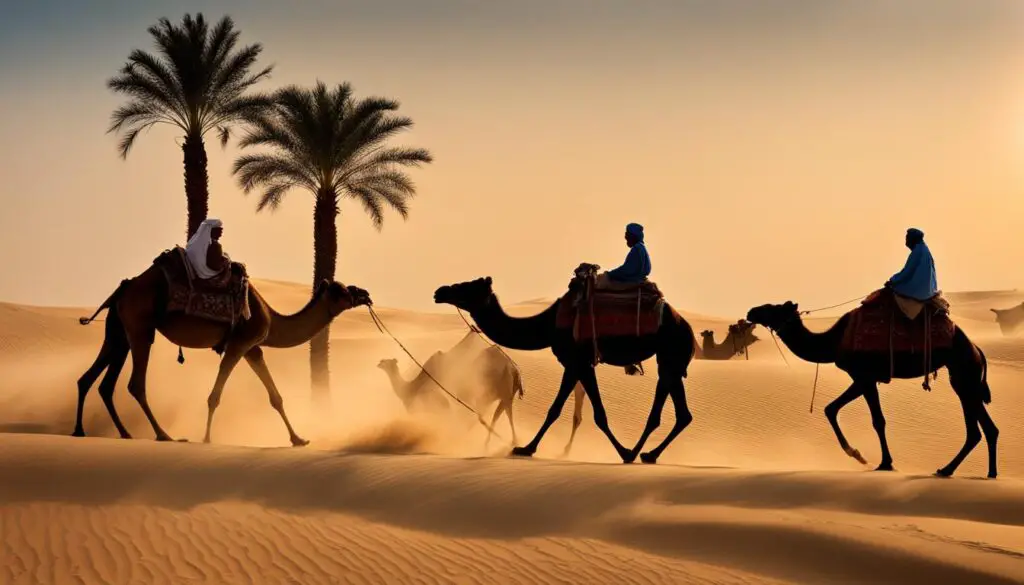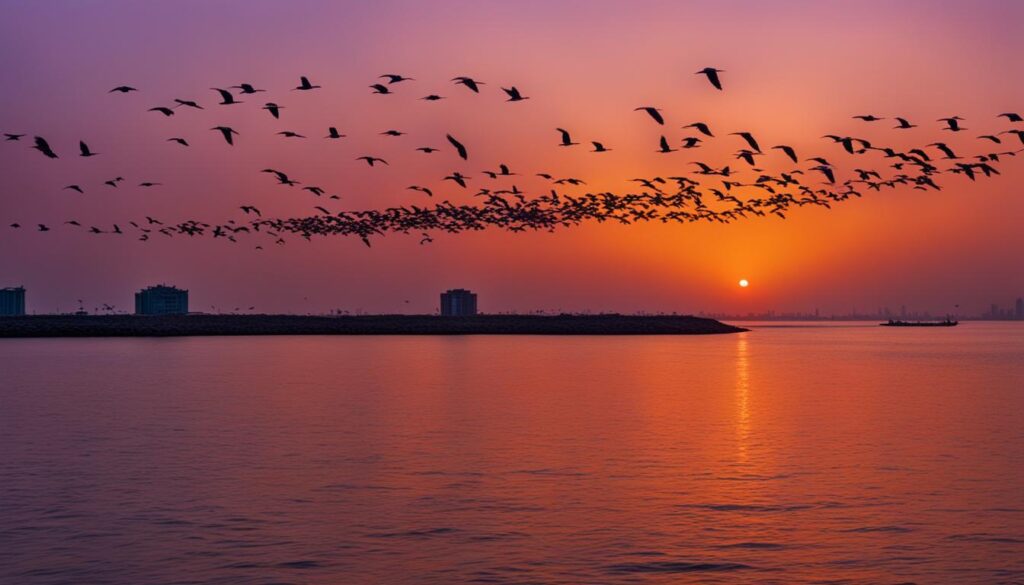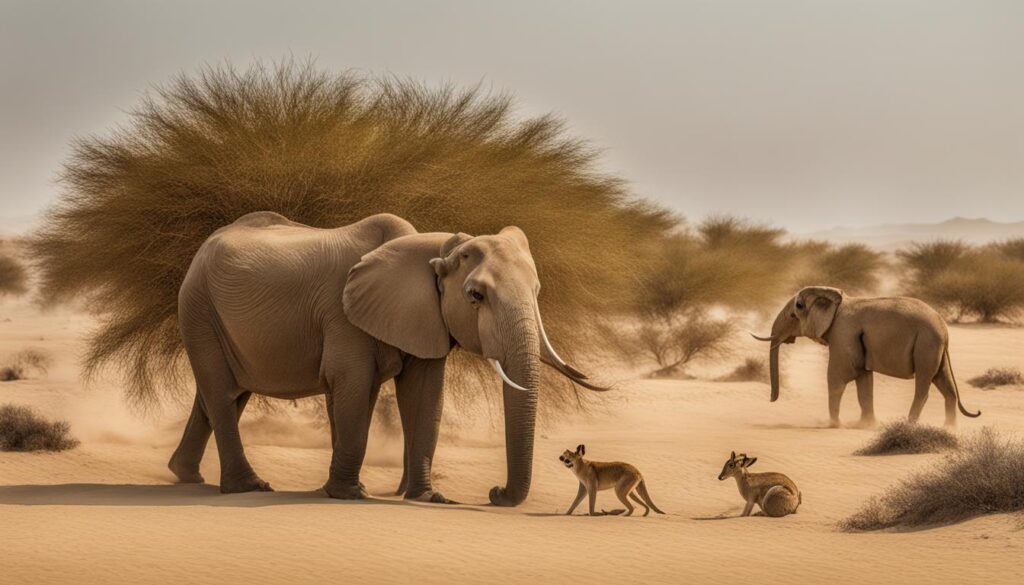Welcome to our article series on the fascinating wildlife in Bahrain. Despite the arid climate, this small country is home to a diverse range of animals and plants. From endangered species to unique adaptations, Bahrain’s animal kingdom holds many surprises. In this section, we will explore the wildlife, endangered species, and animal conservation efforts in Bahrain.

Key Takeaways:
- Bahrain boasts a variety of wildlife despite its arid climate.
- There are 196 species of plants and 17 species of terrestrial mammals in Bahrain.
- The country serves as a stopover for migratory species during autumn and spring.
- Endangered species, such as the Arabian oryx, have been successfully reintroduced.
- Bahrain has made significant strides in animal conservation and welfare.
Flora and Fauna in Bahrain
Bahrain’s unique flora and fauna have adapted remarkably to thrive in the arid conditions of the region. While the country’s landscape may be predominantly desert, there is still a rich variety of native animals that call Bahrain home. These native species have developed incredible survival strategies to withstand the challenges posed by the harsh climate.
The vegetation in Bahrain is mostly concentrated in the northern and western regions of the main island, where agricultural activities are prevalent. Crops like potatoes are cultivated, showcasing the resilience of Bahrain’s agricultural sector in the face of limited water resources. Among the notable landmarks is the Tree of Life, a solitary Prosopis cineraria tree standing tall for over 400 years in the midst of the desert, defying all odds.
The Tree of Life is a symbol of strength and endurance, firmly rooted in Bahrain’s cultural heritage and arid landscape.
When it comes to wildlife conservation, the Al Areen Wildlife Park plays a crucial role. Established in 1976, it serves as the country’s sole protected area and nature reserve. This sanctuary provides a safe haven for various indigenous animal species, offering educational opportunities for visitors and ensuring the preservation of Bahrain’s natural heritage. The park combines the functions of a zoo and a conservation facility, promoting awareness and appreciation of animal conservation efforts.
| Native Animals in Bahrain | Conservation Status |
|---|---|
| Arabian Oryx | Endangered |
| Sand Gazelle | Vulnerable |
| Arabian Hare | Least Concern |
| Indian Grey Mongoose | Least Concern |
| Desert Hedgehog | Least Concern |
Bahrain has recognized the importance of animal conservation and is committed to preserving its unique biodiversity. Efforts are underway to protect and restore habitats, conserve endangered species, and raise awareness about the importance of sustainable practices to ensure the well-being of Bahrain’s flora and fauna for generations to come.
Birds of Bahrain
Bahrain is renowned for its rich diversity of bird species, making it a haven for bird watchers and nature enthusiasts. With over 340 recorded species, the country attracts migratory birds during their autumn and spring migrations, offering a unique opportunity to witness their breathtaking journeys.
The wetlands, cultivated areas, marshes, mudflats, and mangrove swamps of Bahrain provide attractive habitats for a wide range of bird species. These areas are teeming with life, offering abundant food sources and shelter for both resident and migratory birds. The Hawar Islands, designated as an Important Bird and Biodiversity Area, are particularly significant, serving as a breeding ground for various bird species.
Despite the richness of avian life in Bahrain, some bird species face endangerment due to habitat loss and degradation. Efforts are underway to protect these endangered bird species and their habitats through conservation initiatives and the establishment of protected areas. The preservation of these unique ecosystems is crucial for the survival of these bird populations and the overall biodiversity of Bahrain.
“Bahrain’s diverse birdlife is a testament to the country’s commitment to conservation and environmental stewardship. The protection of these magnificent creatures is not only our responsibility but also a gift to future generations.”
Table: Endangered Bird Species in Bahrain
| Species | Status | Main Threats |
|---|---|---|
| Greater Flamingo | Endangered | Habitat loss, pollution |
| Socotra Cormorant | Endangered | Human disturbance, fishing nets |
| White-throated Kingfisher | Vulnerable | Habitat loss, urbanization |
| Western Reef Heron | Least Concern | Coastal development, disturbance |
Source: Bahrain Bird Records Committee
Conservation efforts in Bahrain continue to focus on safeguarding these endangered bird species and their habitats. Through research, education, and community involvement, organizations and government agencies are working together to ensure the long-term survival and well-being of Bahrain’s avian treasures.

Mammals of Bahrain
Bahrain is home to a variety of fascinating mammal species, each uniquely adapted to thrive in the arid conditions of the region. While mammals play a crucial role in maintaining the delicate balance of the ecosystem, some species in Bahrain are facing endangerment due to various factors. Let’s take a closer look at some of the remarkable mammals found in Bahrain and the conservation efforts aimed at protecting them.
The Sand Gazelle
One of the iconic mammals of Bahrain is the Sand Gazelle (Gazella subgutturosa marica), the largest terrestrial mammal in the country. These graceful creatures can be found on Umm an Nasan island as well as Bahrain Island and the Hawar Islands. With their slender bodies and impressive jumping abilities, they have adapted well to the desert environment of Bahrain.
Despite their resilience, the Sand Gazelle population in Bahrain is currently under threat due to habitat loss and hunting. Conservation initiatives are in place to protect this majestic species and ensure its survival for future generations to appreciate.
The Arabian Oryx
The Arabian Oryx (Oryx leucoryx), once extinct in the wild, has been successfully reintroduced to the Hawar Islands. These magnificent creatures, with their elegant white coats and impressive horns, are a symbol of resilience and conservation success. The Arabian Oryx population in Bahrain continues to grow steadily, thanks to ongoing conservation efforts.
| Mammal Species | Status |
|---|---|
| Sand Gazelle (Gazella subgutturosa marica) | Endangered |
| Arabian Oryx (Oryx leucoryx) | Vulnerable |
The protection and conservation of these endangered mammal species in Bahrain are crucial for maintaining biodiversity and preserving the natural heritage of the country. Ongoing efforts by organizations and authorities are focused on habitat restoration, anti-poaching measures, and raising awareness about the importance of wildlife conservation.

Reptiles and Amphibians of Bahrain
Bahrain is home to a diverse range of reptiles and amphibians, each uniquely adapted to survive in the arid conditions of the region. These fascinating creatures play an important role in the ecosystem and contribute to the overall biodiversity of the country.
Reptiles of Bahrain
There are 14 species of reptiles found in Bahrain, showcasing the ability of these creatures to thrive in harsh desert environments. Some notable reptiles include the goitered gazelle, known for its distinctive appearance and ability to survive without water for long periods. The desert hedgehog, with its spikes and nocturnal habits, is another unique reptile found in Bahrain. Additionally, the golden jackal, a cunning predator, is a common sight in the country.
Amphibians of Bahrain
While Bahrain only has a single species of amphibian, it is still an important part of the country’s biodiversity. The lesser Egyptian jerboa, a hopping desert rodent, is the sole representative of the amphibian class in Bahrain. This small creature is a master of survival in the arid desert environment, using its powerful hind legs to navigate the sandy terrain.
These reptiles and amphibians have developed specialized characteristics to adapt to the unique challenges of Bahrain’s climate. Their ability to thrive in such conditions is a testament to their remarkable resilience and adaptation skills.
| Reptiles of Bahrain | Amphibians of Bahrain |
|---|---|
| Goitered Gazelle | Lesser Egyptian Jerboa |
| Desert Hedgehog | |
| Golden Jackal |
These reptiles and amphibians bring a sense of wonder and fascination to the natural world of Bahrain. By preserving their habitats, we can ensure the continued survival and thriving of these unique creatures for future generations to appreciate.
Marine Life in Bahrain
Bahrain’s coastal waters are teeming with diverse marine life, making it a haven for marine enthusiasts and conservationists. The rich biodiversity of the Arabian Gulf supports a wide range of species, including sea turtles, dugongs, seagrass, and extensive coral reefs. Marine life in Bahrain is a crucial part of the country’s natural heritage, contributing to the ecological balance and providing valuable resources for both humans and wildlife.
Sea Turtles
One of the most iconic marine species in Bahrain is the sea turtle. Three species of sea turtles can be found in Bahrain’s waters: the green turtle, the hawksbill turtle, and the loggerhead turtle. These majestic creatures play a vital role in maintaining the health of coral reefs by grazing on seagrass beds and controlling algae growth. However, sea turtles face numerous threats, including pollution, habitat destruction, and entanglement in fishing gear. Conservation efforts in Bahrain aim to protect nesting sites, raise awareness, and promote sustainable practices to safeguard the future of these endangered marine reptiles.
Coral Reefs
The coral reefs in Bahrain are an underwater paradise, showcasing a kaleidoscope of colors and an abundance of marine life. These delicate ecosystems provide shelter, food, and breeding grounds for a wide variety of fish, crustaceans, and other marine organisms. Unfortunately, these reefs are under threat from human activities, such as dredging, pollution, and climate change-induced coral bleaching. To protect and preserve the marine conservation in Bahrain, initiatives are being implemented to raise awareness, regulate fishing practices, and establish marine protected areas that safeguard these fragile habitats.
Dugongs
Bahrain’s coastal waters are home to a significant population of dugongs, also known as sea cows. These gentle marine mammals are herbivores, relying on seagrass meadows as their primary food source. However, habitat destruction and overfishing of seagrass pose significant risks to the survival of dugongs. Conservation efforts in Bahrain focus on monitoring and protecting seagrass habitats to ensure the long-term viability of the dugong population. By promoting sustainable practices and educating the local community, marine conservation in Bahrain strives to safeguard the future of these graceful creatures and their vital habitats.
In conclusion, the marine life in Bahrain is a precious treasure that requires dedicated conservation efforts to protect its fragile ecosystems. By raising awareness, promoting sustainable practices, and establishing marine protected areas, Bahrain aims to safeguard the biodiversity and ecological balance of its coastal waters. It is imperative that we recognize the importance of marine conservation in Bahrain and work together to preserve these valuable resources for future generations to enjoy and appreciate.
Conservation Efforts in Bahrain
Bahrain has taken significant steps in animal conservation and welfare, demonstrating its commitment to protecting its diverse wildlife. One of the key initiatives is the establishment of the Al Areen Wildlife Park, which serves as both a protected area and a zoo. The park provides a safe haven for threatened and endangered species, offering them a suitable habitat and promoting their well-being.
Efforts are also underway to reintroduce species that were once extinct in the wild back into their natural habitats. For example, the Arabian oryx, a magnificent desert antelope, has been successfully reintroduced to the Hawar Islands. These efforts not only contribute to the conservation of these species, but also help to restore the ecological balance and preserve the country’s natural heritage.
Animal welfare organizations in Bahrain play a crucial role in promoting responsible pet ownership and ensuring the well-being of domesticated animals. These organizations focus on adoption and rescue, providing loving homes for abandoned or stray animals. By raising awareness about animal welfare issues and advocating for humane treatment, they contribute to creating a compassionate society where animals are valued and cared for.
Bahrain Animal Adoption and Welfare Organizations
| Organization Name | Website |
|---|---|
| Bahrain Society for the Prevention of Cruelty to Animals (BSPCA) | www.bspca.org |
| Bahrain Animal Rescue Centre (BARC) | www.bahrainanimalrescuecentre.com |
| Animal Care Bahrain | www.animalcarebahrain.org |
These organizations rely on the support and involvement of the community to carry out their mission. They provide adoption services, veterinary care, and educational programs to promote responsible pet ownership and increase awareness about animal welfare. Through their dedication, they are making a positive impact on the lives of animals in Bahrain.
Conclusion
Bahrain’s diverse wildlife showcases the incredible adaptability and resilience of animals in harsh environments. Despite the arid climate, the country is home to a rich array of flora and fauna, including endangered species. Efforts to protect and conserve these animals are paramount to preserving the delicate balance of the ecosystem.
The Al Areen Wildlife Park, serving as a protected area and zoo, plays a crucial role in providing a safe haven for threatened and endangered species. Furthermore, ongoing initiatives are focused on reintroducing extinct species, such as the Arabian oryx and the dugong, back into their natural habitats.
Animal welfare organizations in Bahrain are actively involved in adoption, rescue, and promoting responsible pet ownership. Their dedication and commitment contribute to the well-being and protection of animals throughout the country.
Bahrain’s commitment to animal conservation and welfare ensures that future generations can continue to appreciate and enjoy the magnificent diversity of animals that make this region their home.
FAQ
What kind of wildlife can be found in Bahrain?
Bahrain is home to 196 species of plants, 17 species of terrestrial mammals, numerous birds and reptiles, and migratory species that visit the islands in autumn and spring.
Where can I find the Tree of Life in Bahrain?
The Tree of Life, a lone Prosopis cineraria tree that is over 400 years old, is located in the north and west of the main island of Bahrain.
Are there any protected areas for wildlife in Bahrain?
Yes, the Al Areen Wildlife Park, established in 1976, is the only protected area in Bahrain and serves as a nature reserve and zoo.
How many bird species are recorded in Bahrain?
Over 340 species of birds have been recorded in Bahrain, making it a paradise for bird watchers.
Where can I find attractive habitats for birds in Bahrain?
Wetlands, cultivated areas, marshes, mudflats, and mangrove swamps are all attractive habitats for birds in Bahrain.
What mammals can be found in Bahrain?
Bahrain is home to mammals such as the sand gazelle, Arabian hare, desert hedgehog, Indian grey mongoose, and bats.
Are there any reptiles and amphibians in Bahrain?
Bahrain is home to 14 species of reptiles and a single species of amphibian.
What marine life can be found in Bahrain?
Bahrain’s coastal waters are home to a variety of marine life, including sea turtles, dugongs, seagrass, and extensive coral reefs.
What conservation efforts are taking place in Bahrain?
Bahrain has made significant strides in animal conservation and welfare, with efforts including the Al Areen Wildlife Park and reintroduction programs for extinct species.
